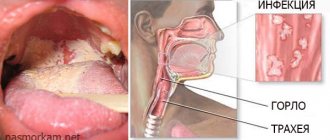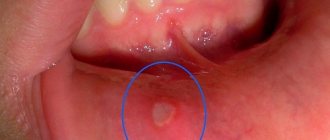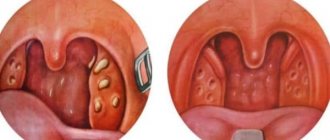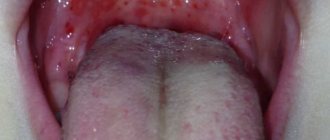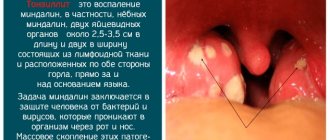To treat a red, friable throat in a child, rinsing, inhalation, and local disinfectants are often used. Antibiotics and traditional methods are not suitable for young patients.
If an adult has been diagnosed with loose tonsils, treatment includes, in addition to rinsing and inhalation, antiviral, antibacterial or antifungal drugs, and anti-inflammatory drugs. For those with chronic tonsillitis and other persistent pathologies, prevention is important to keep the throat and tonsils healthy.
Causes
Having discovered loose tonsils in the throat of yourself or your baby, which are accompanied by signs of inflammation, you should consult a specialist to determine the cause of this disorder, most often it is:
- acute tonsillitis (staphylococcal tonsillitis);
- chronic tonsillitis;
- acute or chronic pharyngitis;
- colds, bacterial, fungal or viral infections of the throat, larynx, bronchi and lungs;
- autoimmune diseases, acute allergic reaction.
Sometimes loose tonsils in a child are a congenital pathology of lymphoid tissue, in which its hypertrophy is observed, but it functions normally, supporting local immunity.
A loose red throat is a sign of acute respiratory infection
Redness, along with swelling, pain and mucus production are classic signs of inflammation. A red, loose throat is a typical manifestation of an acute inflammatory reaction in the upper respiratory tract. Acute respiratory diseases (i.e. acute respiratory infections) that affect the throat area include:
- tonsillitis - inflammation of the pharyngeal tonsils;
- pharyngitis - inflammation of the mucous membrane of the pharynx;
- Laryngitis is inflammation of the larynx.
With tonsillitis, the infection is localized in the tonsils. The tonsils (or tonsils) become inflamed - enlarged, reddened, and covered with plaque. If the tonsils are not enlarged, but the throat is red, especially the visible part of the back wall, pharyngitis occurs.
With laryngitis, the throat can be red and loose only if the pharynx is involved in the infectious process. It is impossible to see an inflamed larynx when examining the throat, so the diagnosis of “laryngitis” is made on the basis of external symptoms, primarily, changes in voice (hoarseness, wheezing).
Thus, a red throat with a loose surface indicates acute inflammation of the tonsils or pharynx. The child has either tonsillitis or pharyngitis.
Associated symptoms
To find out why the tonsils are loose, it is necessary to conduct an external examination, do a bacterial culture of a throat smear and collect an anamnesis - a set of accompanying symptoms, as they will help clarify the diagnosis.
In acute tonsillitis, enlarged tonsils and a red, loose throat in a child or adult are accompanied by severe pain when swallowing, fever, chills, and weakness. A clear sign of staphylococcal tonsillitis is a pale plaque with a bad odor - purulent discharge formed due to the surface activity of bacteria.
Chronic tonsillitis is not so pronounced, there is no fever, the back wall of the throat is constantly loose in a child or an adult, the tonsils are always hypertrophied, hard plugs often fall out of them, hyperemia - there is no redness of the tissues, there is an unpleasant odor from the mouth.
Acute or chronic pharyngitis is a pathology of the mucous tissues of the throat, accompanied by fever, severe sore throat, discomfort when swallowing or eating food. The patient observes a change in the timbre of the voice, wheezing appears, the throat is red and swollen, and sometimes rhinitis occurs.
A cold, bacterial or viral infection is accompanied by fever, body aches, chills, weakness, and a white coating appears on the tonsils. During such pathologies, the patient experiences problems with the digestive system: loss of appetite, constant nausea, bad stool.
What does a loose throat mean?
Loose throat - this definition can often be heard from doctors. What does this mean and whether something needs to be done - there are different answers to these questions. Many doctors are convinced that this is a pathology that needs to be treated, others think differently. So, loose throat.
What is a “loose throat”, why does it become like this?
The term “loose throat” refers to the condition of the tonsils, which differs from the condition of healthy ones in its appearance - the tissue of the tonsils is not smooth and even, but rather loose. In this case, there may not be redness of the tonsils and walls of the larynx. Is this throat condition dangerous? It depends on why the throat acquired this appearance.
And there are only two reasons.
Viruses
Firstly, the tonsils become loose under the influence of pathogenic microbes, which appear in huge numbers and multiply in sore throat (tonsillitis). As a result, an inflammatory process begins in the tonsils, since the structure of the tonsils is disrupted (pathogenic microbes primarily attack the tonsils).
After the inflammatory process has subsided, the throat may not regain its original state for a long time, and since the body is weakened, it is more susceptible to the effects of viruses.
Therefore, a person can get sick again very quickly, and the tonsils will again take on a loose appearance.
Gradually, the process becomes chronic, as a result of which even during the period of remission the throat looks loose.
Only timely and correct treatment can stop the process of transition from acute to chronic and restore the protective forces of the tonsils.
Physiological feature
The second reason for an always loose throat (but not red) is a physiological feature of the human body.
In this case, this feature serves as a “bad service” - the throat “catches” any infection, and faster than a normal throat.
That is why, in these cases, doctors advise parents whose child has such a throat from birth not to eat with the same utensils, not to lick his spoons, toys, pacifiers, and try not to kiss him on the lips.
Any infection very quickly sticks to a throat that is loose from birth; allergens have a stronger effect on such a throat, while on a normally healthy throat the same allergens may not have any negative effect. Irritation from allergens and other irritants is always stronger than in the case of a physiologically normal throat.
What to do with a loose throat?
The answer to this question is obvious. If looseness appears as a result of a previous illness - sore throat, pharyngitis, etc., you need, firstly, to start treatment as early as possible and carry it out to the end, and secondly, immediately begin all possible preventive measures, including general hardening and other procedures .
In principle, there is nothing terrible about this condition of the throat, and if you have it all the time, you should just lead a healthy lifestyle, try not to get hypothermic and not get nervous, then going to the doctors and then swallowing pills will not be necessary.
That is, in other words, if your throat is loose, but not red, you are healthy, and you don’t need to do anything except constantly maintain your health.
If your throat suddenly becomes loose, be wary - an inflammatory process is beginning, you need to urgently take action - gargle with antiseptic solutions, drink vitamins, do not eat spicy, too hot or cold foods.
Source: https://nmedicine.net/ryxloe-gorlo-chto-eto-oznachaet/
Treatment
Therapy for a loose pharynx is necessary in cases where the patient experiences tissue hyperemia, elevated temperature and other signs of pathology. You should not choose medications on your own, because to draw up a treatment regimen you need to know the exact cause of the disorder.
In children
When the pediatrician has determined why the child has a loose throat, it is necessary to begin therapy. The main procedures for young patients are gargling and inhalation. They allow you to wash your tonsils and throat, remove excess mucus, and reduce inflammation. For rinsing, use a weak solution of salt and iodine, Furacilin or pharmacy calendula tincture. For inhalation, take Rotokan, saline solution or mineral water.
Antibiotics are rarely used, since such treatment of a child’s sore throat has a negative impact on his well-being. Sprays (Ingalipt, Chlorophyllipt, Bioparox, Tantum-Verde) and Lugol, which are used to lubricate the surface of the throat, are suitable for disinfecting the throat.
In adults
In addition to rinses, inhalations and medications for external treatment approved for children, antibiotics of the penicillin or macrolide series, antiviral (Ocilococcinum, Arbidol) and antifungal (Miramistin and similar external treatment agents) drugs, lozenges (Decatylene, Faringosept, Septolete) are added.
Adults may be prescribed physiotherapy, for example, warming the throat with ultraviolet light, as well as artificial cleansing of the tonsils - the doctor uses ultrasound to remove plugs from the tonsils and treat them with an antiseptic solution.
Acute tonsillitis
Acute tonsillitis is an inflammation of the tonsils. Its symptoms:
- enlargement and redness of the tonsils, as well as the pharynx, soft palate and uvula;
- tuberosity of the mucous membrane of the tonsils, caused by an increase in their follicles (“loose throat”);
- acute pain in the throat, making it difficult to swallow;
- enlarged cervical lymph nodes;
- fever (in children, body temperature often reaches 39C);
- Plaque may form on the tonsils in the form of dots, spots, or films.
Tonsillitis can be caused by viruses or bacteria. Acute tonsillitis caused by a bacterial infection is called tonsillitis. Among bacterial pathogens, the most common is streptococcus. Streptococcal sore throat must be treated with antibiotics, and viral sore throat must be treated with antiviral agents.
The doctor decides whether to include antibiotics in the treatment plan. You should not refuse antibiotics if they are prescribed - untreated sore throat often leads to complications in the heart, joints and kidneys.
In addition to antibiotics or antiviral drugs, treatment of tonsillitis should include antiseptic drugs for local therapy (rinsing and treating the tonsils). You can use the same remedies that are prescribed for pharyngitis. In addition, for tonsillitis with loosening of the tonsils, resorption of tablets is indicated to restore the structure and functions of lymphadenoid tissue. These include the drug Tonsilotren.
Prevention
Prevention should be performed regularly (2-3 times a week) if an adult or child has a constantly loose throat, chronic tonsillitis, autoimmune diseases, or frequent infectious pathologies of the throat. The list of supporting procedures includes:
- gargling using a solution of salt and soda in equal proportions (1 tsp per glass of water);
- rinsing with a solution of sea salt and iodine (per glass of water requires 1 tablespoon of salt and 5 drops of pharmaceutical iodine solution);
- rinsing with Furacilin solution (2 tablets per glass of water);
- inhalations with mineral waters or pharmaceutical saline;
- rinsing the nose with saline;
- gargling with herbal decoctions (sage, chamomile, oak bark, nettle, celandine), but these procedures are only suitable for adults, because medicinal plants often cause allergies in children.
A loose throat and tonsils are a sign of an active fight by the immune system against pathogenic microorganisms, as well as an autoimmune reaction or chronic tonsillitis. To make a diagnosis, you need to contact a specialist who will conduct an examination, collect anamnesis and tests.
Therapy for adults and children is different, since many drugs are contraindicated for young patients. Those with chronic throat diseases and those who often get throat infections should follow preventive measures to prevent the situation from getting worse.
Author: Valentina Melnik, specialist, especially for lechim-gorlo.ru
Causes of a loose throat in adults
Lymphoid tissue is a kind of filter that traps pathogens. The doctor uses the term “loose throat” when he sees the tuberosity of the lymphoid tissue in a patient.
Swelling of the tonsils and uneven surface of the walls of the palate - all this indicates the entry of pathogenic microbes and viruses into the body. An adult may have a sore throat due to colds, laryngitis and tonsillitis.
If this phenomenon occurs without high temperature and purulent plaque, then there is nothing to worry about. But even in this case, treatment must be started immediately.
Causes
A loose throat can cause viruses and bacteria to enter the body. But this condition is often physiological.
Viral diseases
Rarely occurring respiratory diseases do not lead to irreversible changes in lymphoid tissue. But if such diseases occur against the background of reduced immunity or other pathologies of a systemic nature, this can lead to a number of complications.
Viral infections are most often transmitted by airborne droplets from a sick person to a healthy one. The incubation period can last up to 4 days. The clinical picture always depends on the type of virus that has entered the body:
- Adenoviral infection. The patient has a severe runny nose, high fever, wet cough and enlarged regional lymph nodes. If the disease is severe, sinusitis, laryngitis or bronchitis may develop within a few days. When examining a patient, the doctor may see a loose throat and tonsils covered with a white coating.
- MS infection. With this disease, there is a severe cough with thick sputum, pain when swallowing, low-grade fever and swelling of the tonsils. When the body is affected by such viruses, there is a high probability of damage to the bronchioles, which leads to respiratory failure.
- Flu. This disease always begins very acutely. The patient has a high temperature that is difficult to control, chills and joint pain. A day later, these symptoms are supplemented by a runny nose, cough and severe headache. The patient is very weak and has no appetite. When examining the throat, the doctor may note severe looseness of the lymphoid tissue.
Viral pathologies are more severe in some chronic diseases - sinusitis, tonsillitis or bronchitis. Autoimmune disorders can provoke viral diseases.
With frequent illnesses, a loose throat becomes a constant source of infection in the body.
Tonsillitis
A sore throat may indicate chronic tonsillitis. If a sore throat occurs up to 2 times a year, then the risk of complications is minimal. But if the incidence rate reaches 4 cases per year or more, then a chronic form of the disease may develop.
If streptococci often get on the lymphoid tissue of the throat, then over time it becomes loose, which allows the pathogens to be kept within the oropharynx.
There are several forms of chronic tonsillitis. They all differ in the nature of the disease and the intensity of symptoms. During periods of remission, the temperature may be normal or slightly elevated; in addition, the patient is bothered by abnormal fatigue and drowsiness.
For chronic tonsillitis to worsen, it is enough to drink cold water, catch a cold or become very nervous. The cause of chronic tonsillitis can be a deviated nasal septum, adenoiditis or hay fever.
Chronic tonsillitis is manifested by sore throat, loose lymphoid tissue, high fever and general malaise. In the acute period of the disease, the mucous membrane of the throat becomes very red and swollen, and a whitish coating appears on the tonsils.
The disease is diagnosed based on anamnesis, examination of the patient and culture data.
Pharyngitis
A common cause of a sore throat in adults is pharyngitis. This disease can develop for the following reasons:
- Entry of viruses and bacteria into the body.
- Fungal infection of the mucous membrane. This is often observed with prolonged treatment with antibiotics and chemotherapy.
- Polluted air. This type of pharyngitis is often diagnosed in workers in hazardous industries.
- Chronic sinusitis.
The symptoms of pharyngitis are quite specific. These include a sore throat, loose tonsils, a feeling of a foreign object in the throat, and viscous mucus that is very difficult to cough up. Lymph nodes greatly increase in size.
The most severe form of pharyngitis is atrophic. It is characterized by severe thinning of the mucosa and the formation of ulcers and crusts.
Physiological feature
A constantly loose throat may be a physiological feature of the human body. In this case, a person is more susceptible to respiratory diseases, since loose tissue catches pathogens faster. For those people who have such a throat, doctors advise especially careful hygiene, not to eat with other people's cutlery, and to have their teeth treated in a timely manner.
A sore throat is greatly affected by allergens. At the same time, even those substances that a person with normal lymphoid tissue does not notice at all can provoke allergies.
Treatment
You need to start treating a sore throat in an adult as early as possible. Treatment is selected individually, depending on the diagnosis and examination data. Before prescribing medications, a throat swab must be taken to determine the pathogen and its sensitivity to certain drugs.
If the disease is caused by bacteria, then the treatment protocol must include antibacterial drugs. Preference is usually given to broad-spectrum antibiotics. Local antiseptics can also be used.
For a loose throat, all kinds of gargles have a good effect. For rinsing, you can use solutions prepared at home or pharmaceutical preparations. Your doctor may recommend the following formulations:
- Chamomile decoction.
- Yarrow decoction.
- A decoction of a herbal collection that includes chamomile, calendula, eucalyptus and elecampane.
- An aqueous solution of calendula tincture. To do this, take a dessert spoon of alcohol tincture into a glass of warm water. This composition disinfects a loose throat well.
- Furacilin solution. To prepare, take two crushed tablets and dissolve them in a glass of hot water.
- Miramistin. To rinse, you can use a clear solution or treat your tonsils with a spray.
Pharmacy antiseptic solutions should not be used if the soreness of the throat is not accompanied by pain and redness. In this case, it is better to use a sea salt solution for treatment.
It is prepared from a glass of water and a full teaspoon of salt. To prepare the solution, you can use not only sea salt, but also table salt. In this case, a couple of drops of alcohol tincture of iodine should be added to the composition.
In the acute period, it is recommended to gargle every hour.
Experts recommend gradually reducing the temperature of gargling solutions. This leads to hardening and increased local immunity.
What to pay attention to
To quickly get rid of a sore throat or pharyngitis and prevent the development of complications, you should follow these recommendations:
- In the acute period of the disease, bed rest is required.
- Eat well. The diet should contain natural foods rich in vitamins and nutrients.
- Drink a lot. The patient must be constantly given fortified drinks. This can be a rosehip decoction, decoctions of medicinal herbs, juices, compotes and fruit drinks.
- The patient should be restricted from communicating with people suffering from respiratory diseases.
- During the recovery period after illness, you need to walk a lot in the fresh air, away from dusty roads and factories. You should always dress appropriately for the weather.
- Any contact with allergens should be limited.
Do not forget about maintaining optimal temperature and humidity in your home. For a person with a loose throat, drying out of the mucous membrane is very dangerous.
Timely treatment will help prevent the disease from becoming chronic. If you have a loose throat for a long time, your doctor may recommend having your tonsils removed.
Source
Source: https://neosensys.com/lor/prichiny-ryhlogo-gorla-u-vzroslyh/
How to cure tonsillitis
If a loose throat is a consequence of a chronic inflammatory process, this is not a death sentence at all. Modern medicine has new methods for treating tonsillitis, and some of them have proven to be very effective.
- Vacuuming is the suction of purulent contents from the lacunae of the tonsils. After the procedure, the throat is treated with an antiseptic solution with an antibiotic.
- Washing the tonsils. The procedure is carried out with a 100 ml syringe, with which the otolaryngologist treats loose tonsils with an antiseptic solution.
- Ultraviolet, laser therapy and ultrasound are local disinfecting effects on the tonsils.
The above physiotherapeutic procedures are a chance to cure and preserve tonsils. If left untreated, tonsillitis can become a direct indication for their removal. Vacuuming has proven to be the most effective. The duration of treatment is 1.5-2 months.
Surgery is a last resort. Today, doctors advocate preserving the tonsils, even if the child has a loose throat and suffers from sore throats. However, if tonsillitis takes an acute form 3-4 times a year, the tonsils have to be cut out.
Obviously, loose tonsils in a child are not a reason to panic, but parents should make every effort to prevent this condition from developing into chronic tonsillitis. Sanitation of the oral cavity and larynx, rinsing and taking appropriate medications to strengthen the baby’s local immunity will help cope with this problem. If you take all preventive measures and follow the recommendations of the otolaryngologist, your throat will be healthy.
Lymphoid tissue is a kind of filter that traps pathogens. The doctor uses the term “loose throat” when he sees the tuberosity of the lymphoid tissue in a patient. Swelling of the tonsils and uneven surface of the walls of the palate - all this indicates the entry of pathogenic microbes and viruses into the body. An adult may have a sore throat due to colds, laryngitis and tonsillitis. If this phenomenon occurs without high temperature and purulent plaque, then there is nothing to worry about. But even in this case, treatment must be started immediately.
